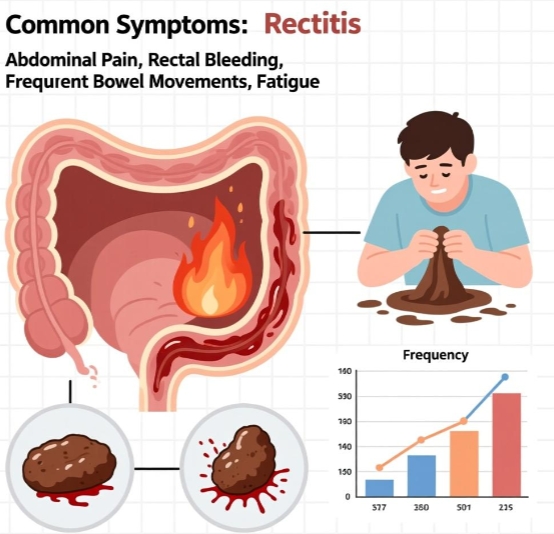Proctitis is inflammation confined to the distal 12–15 cm of the rectum. It may be acute or chronic, infectious, inflammatory, radiation-induced, or ischemic. Because the rectum serves as the final stool reservoir, even limited mucosal irritation produces prominent local symptoms that patients notice immediately and often attribute mistakenly to hemorrhoids.
- Cardinal rectal symptoms
• Tenesmus: a persistent, sometimes painful urge to defecate despite an empty rectum; may interrupt sleep and mimic urinary urgency in severe cases.
• Urgency: a sudden, compelling need to reach a toilet; accidents occur if access is delayed even a few minutes.
• Frequent, small-volume stools: five to ten passages daily, each <50 g, occasionally consisting only of mucus or blood.
• Rectal bleeding: bright red streaks on toilet paper, blood coating formed stool, or drops into the pan; clots are rare unless deep ulceration exists.
• Mucus discharge: clear, white, or blood-tinged slime expelled with or between stools. - Associated discomfort
• Burning or aching in the anal canal during and after defecation, often worse when stools are hard.
• Sensation of incomplete evacuation or “blockage,” leading to repeated straining that further traumatizes the mucosa.
• Mild cramping in the suprapubic area; pain rarely localizes to the right or left lower quadrant because the inflamed segment is midline. - Systemic and context clues
• Low-grade fever and malaise: suggest bacterial or sexually acquired proctitis.
• Nocturnal diarrhea: uncommon; if present, consider proximal extension (proctosigmoiditis).
• Concurrent skin or oral lesions: psoriasis plaques, erythema nodosum, or aphthous ulcers point toward inflammatory bowel disease.
• History of anal-receptive intercourse, recent antibiotic use, or pelvic radiation: guides microbiologic testing and timing of onset. - Specific patterns by cause
• Radiation proctitis: painless bleeding 6–18 months after pelvic radiotherapy, often with rectal pain and spasm.
• Ischemic proctitis: sudden bloody diarrhea in older adults with vascular risk factors; pain out of proportion to visible bleeding.
• Diversion proctitis: mucus discharge and urgency months after colostomy formation in an unused rectal stump. - Red-flag combinations
Continuous bleeding with orthostatic dizziness, passage of large clots or melena (implying a more proximal source), severe anal pain suggesting abscess or fistula, and weight loss >5 % within four weeks.
Summary table
| Key symptom | Typical quality | When to suspect extension or complications |
|---|---|---|
| Tenesmus | Frequent false urges | Persistence >2 weeks despite topical therapy |
| Blood on paper | Bright red, scant | Clots or melena → colonoscopy required |
| Mucus only | Clear or pink | Copious pus → culture for STI |
| Urgency | <5 min warning | Accidents, nocturnal awakening → evaluate proximal spread |
| Anal pain | Burning during stool | Throbbing, swelling → rule out abscess |
